Saludos cordiales, comunidad de Foodies Bee Hive. En esta ocasión, prepararemos un plato de la gastronomía mexicana, la Birria, que se trata de una preparación de carne, generalmente de carnero o res, que se estofa en una salsa o consomé que se prepara con una combinación de chiles, tomates, cebolla y cilantro, y se sirve deshebrada o cortada en trozos en el consomé y se acompaña con cebolla picada y cilantro, y se come con tortillas.
En nuestro caso, haremos una especie de aproximación a la birria, pues la preparación original se hace con un surtido de chiles secos ahumados, que no hay disponibles en mi país, así que yo use algunos chiles frescos, encurtidos y pimientos picantes humados en polvo, para sustituirlos. Espero que les guste.
Warm greetings, Foodies Bee Hive community. On this occasion, we will prepare a dish of Mexican gastronomy, Birria, which is a preparation of meat, usually mutton or beef, which is braised in a sauce or consommé that is prepared with a combination of chiles, tomatoes, onion and cilantro, and served shredded or cut into pieces in the consommé and accompanied with chopped onion and cilantro, and eaten with tortillas.
In our case, we will make a sort of approximation to birria, as the original preparation is made with an assortment of smoked dried chiles, which are not available in my country, so I used some fresh chiles, pickled and smoked hot bell pepper powder, to substitute them. I hope you like it.


Ingredientes
- 1/2 kg de carne de res para guisar, yo use falda
- 1 o 2 cebollas
- 4 tomates
- 2 ajíes dulces
- 1 chile serrano encurtido o fresco
- 4 dientes de ajos grandes
- 1 ramillete de perejil
- 1 ramillete de cilantro
- 1 1/2 cucharaditas de pimentón ahumado picante (paprika)
- 1/2 cucharadita de pimienta de Jamaica o guayabita
- 1/2 cucharadita de canela en polvo
- 1 cucharadita de comino en grano
- 4 o 5 clavos especie
- 1 1/2 cucharaditas de orégano seco
- 3 o 4 hojas de laurel secas
- Sal, pimienta, adobo y sazonador al gusto
- Aceite para saltear
Ingredients
- 1/2 kg beef for stewing, I used skirt steak
- 1 or 2 onions
- 4 tomatoes
- 2 sweet peppers
- 1 pickled or fresh serrano chile bell pepper
- 4 large cloves of garlic
- 1 bunch of parsley
- 1 bunch cilantro
- 1 1/2 teaspoons hot smoked paprika
- 1/2 teaspoon allspice or guayabita pepper
- 1/2 teaspoon cinnamon powder
- 1 teaspoon cumin grains
- 4 or 5 cloves spice
- 1 1/2 teaspoons dried oregano
- 3 or 4 dried bay leaves
- Salt, pepper, adobo and seasoning to taste
- Oil for sautéing

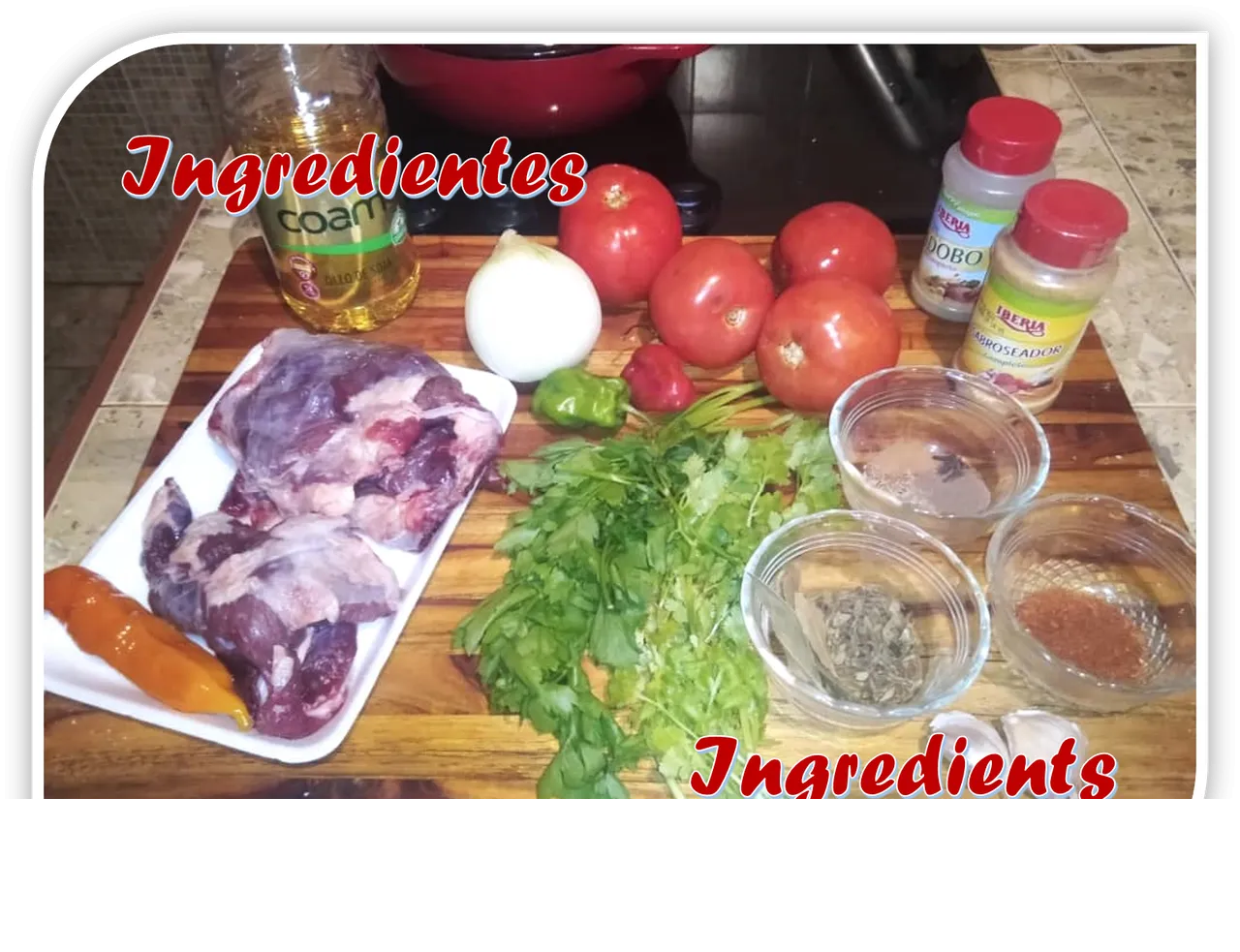

Procedimiento
Para empezar, lavaremos bien los vegetales y cortaremos los tomates, cebolla en trozos, retiraremos las semillas a los chiles y también los cortaremos, no tiene que ser cortes pequeños. Pelaremos los ajos y cortaremos el perejil y el cilantro también en trozos no muy pequeños [1]. Luego de esto pondremos al fuego una olla lo suficientemente grande con dos o tres cucharadas de aceite [2], cuando el aceite empieza a humear un poco, colocaremos los vegetales [3], los mezclaremos [4] y sazonaremos con adobo, sal, pimienta y el pimentón ahumado picante [5], y dejaremos cocinar por unos tres o cuatro minutos.
Procedure
To start, wash the vegetables well and cut the tomatoes and onion into pieces, remove the seeds from the chili peppers and cut them too, it doesn't have to be small cuts. Peel the garlic and cut the parsley and cilantro also in not very small pieces [1]. After this we will put on the fire a big enough pot with two or three spoonfuls of oil [2], when the oil starts to smoke a little, we will put the vegetables [3], mix them [4] and season with adobo, salt, pepper and the hot smoked paprika [5], and let it cook for about three or four minutes.

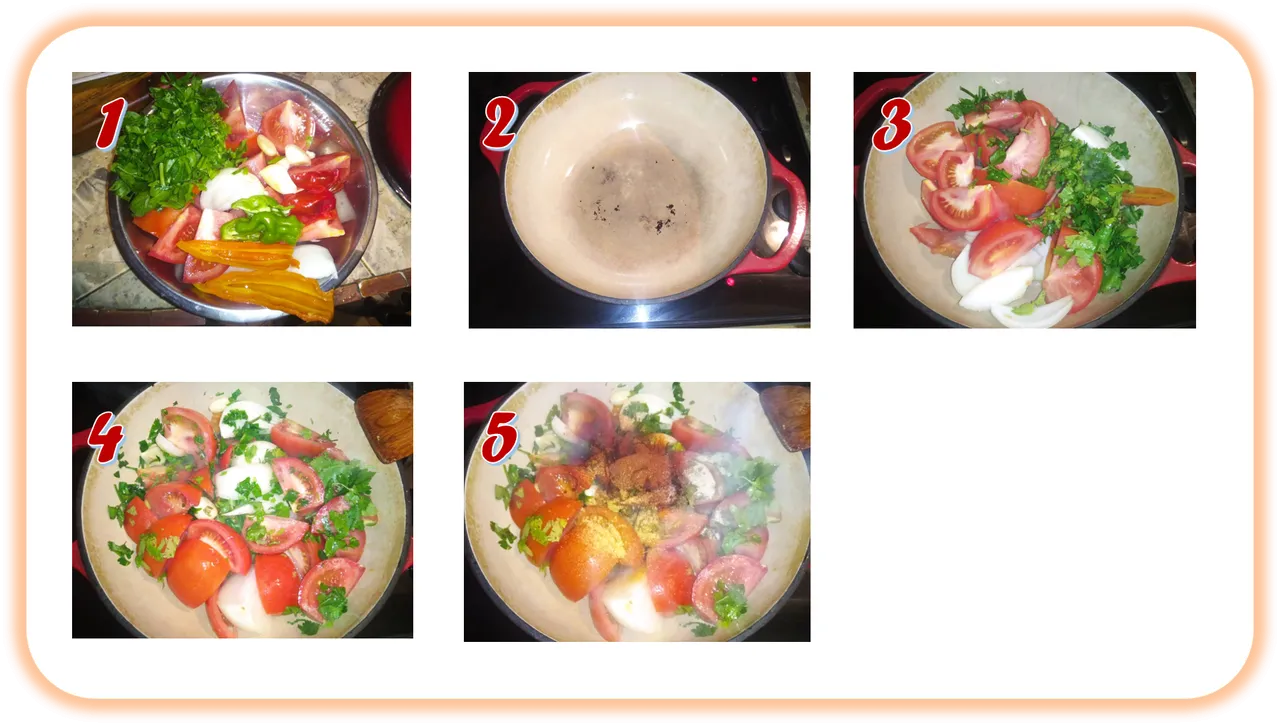

En un mortero, colocaremos la pimienta de Jamaica, el comino, la canela y los clavos de especie [6] y los trituraremos lo mejor posible, hasta obtener un polvo [7], lo agregaremos a los vegetales [8], lo mezclaremos y continuaremos cocinando por otros tres a cinco minutos, agregaremos el orégano seco, triturándolo previamente con la mano [9] y dejaremos cocinar hasta que los vegetales estén blandos y empiecen a caramelizarse un poco [10], luego los retiraremos de la olla y los llevaremos a una licuadora a la que además agregaremos agua o caldo de pollo o vegetales, hasta completar un litro [11].
In a mortar, place the allspice, cumin, cinnamon and cloves [6] and grind them as well as possible until you get a powder [7], add it to the vegetables [8], mix it and continue cooking for another three to five minutes, add the dried oregano, crushing it previously by hand [9] and let it cook until the vegetables are soft and begin to caramelize a little [10], then remove them from the pot and take them to a blender to which we will also add water or chicken or vegetable broth, until completing one liter [11].

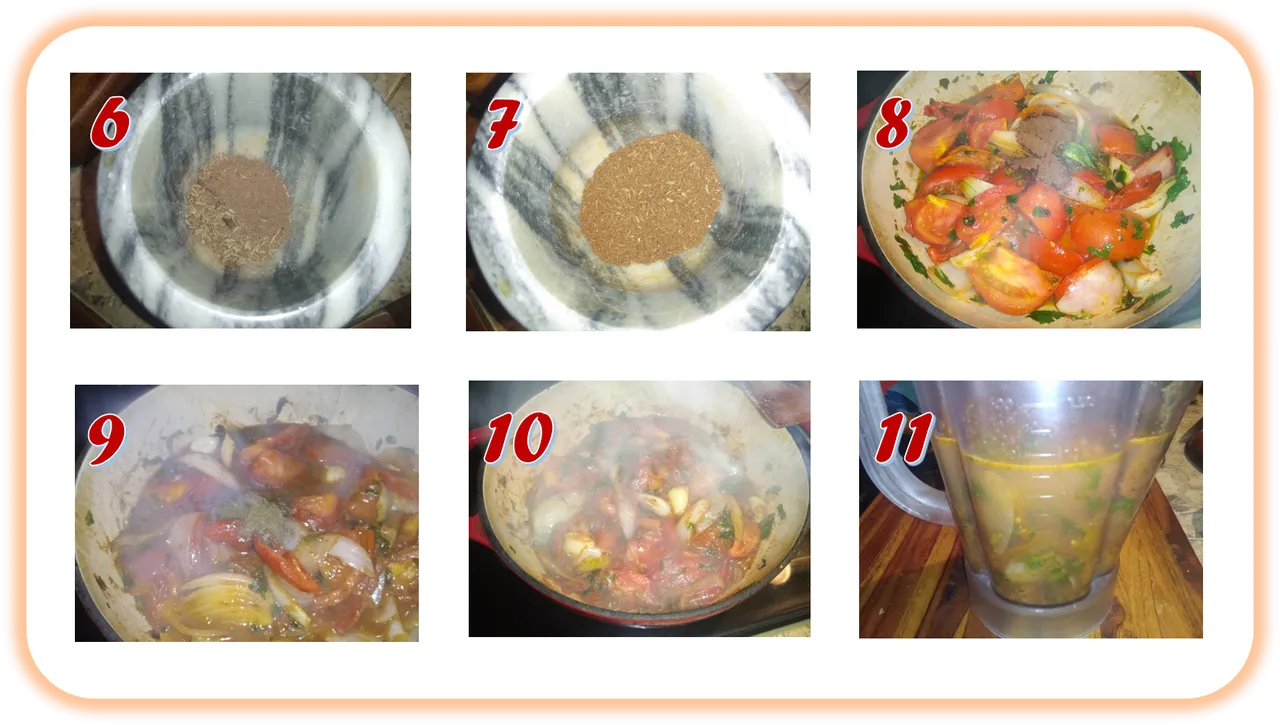

En la misma olla donde cocinamos los vegetales, colocaremos otras dos o tres cucharadas de aceite y al estar caliente, pondremos las piezas de carne a dorar [12], cuando esté dorada por todos los lados [13], agregaremos la salsa que habíamos licuado [14], a la olla con la carne [15], hasta cubrirla y le agregaremos las hojas de laurel [16], si faltase líquido podemos completar con agua caldo. A partir de este momento dejaremos cocinar a fuego medio bajo, por unas tres horas, hasta que la carne se haya ablandado lo suficiente como para deshebrarla, tendremos cuidado de que no pierda demasiado líquido, pues queremos que al final conserve suficiente consomé, durante la cocción el caldo se hará un poco más denso y sabroso, además de tomar un profundo color rojizo.
In the same pot where we cooked the vegetables, we will place another two or three spoonfuls of oil and when it is hot, we will put the pieces of meat to brown [12], when it is browned on all sides [13], we will add the sauce that we had liquefied [14], to the pot with the meat [15], until it is covered and we will add the bay leaves [16], if there is not enough liquid we can complete with broth water. From this moment on we will let it cook at medium low heat, for about three hours, until the meat has softened enough to shred it, we will be careful that it does not lose too much liquid, because we want it to keep enough consommé at the end, during the cooking the broth will become a little more dense and tasty, besides taking a deep reddish color.

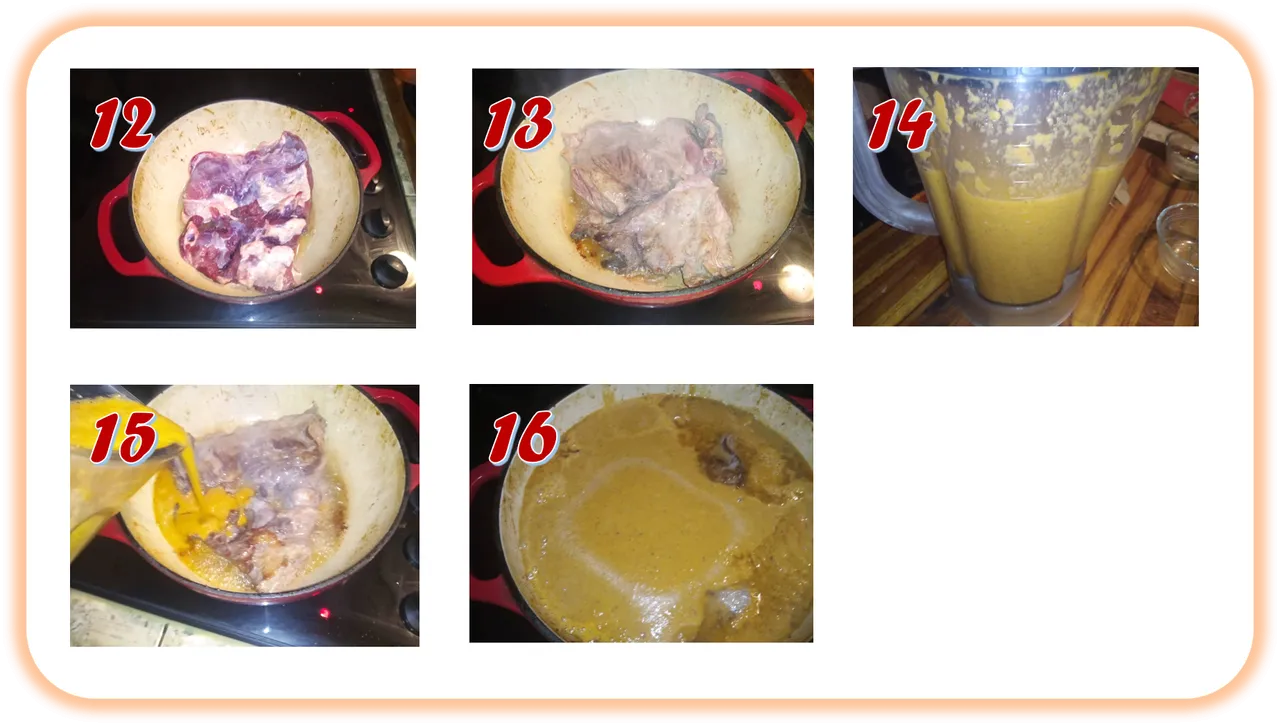

Cuando la carne se haya ablandado, la retiraremos del consomé [17] y usando un tenedor y una cuchara o pinza la deshebraremos [18], también puede ser con las manos, pero la carne estará caliente, o podemos usar un cuchillo y trocearla en partes pequeñas, una vez deshebrada la carne [19], la agregaremos en el consomé [20] y dejaremos que se cocine por unos minutos en él, para que adquiera todo el sabor [21], la retiraremos del fuego y estará lista para servir.
When the meat has softened, remove it from the consommé [17] and using a fork and a spoon or tongs, shred it [18], you can also shred it with your hands, but the meat will be hot, or you can use a knife and cut it into small pieces, once the meat has been shredded [19], add it to the consommé [20] and let it cook for a few minutes in it, so that it acquires all the flavor [21], remove it from the fire and it is ready to serve.

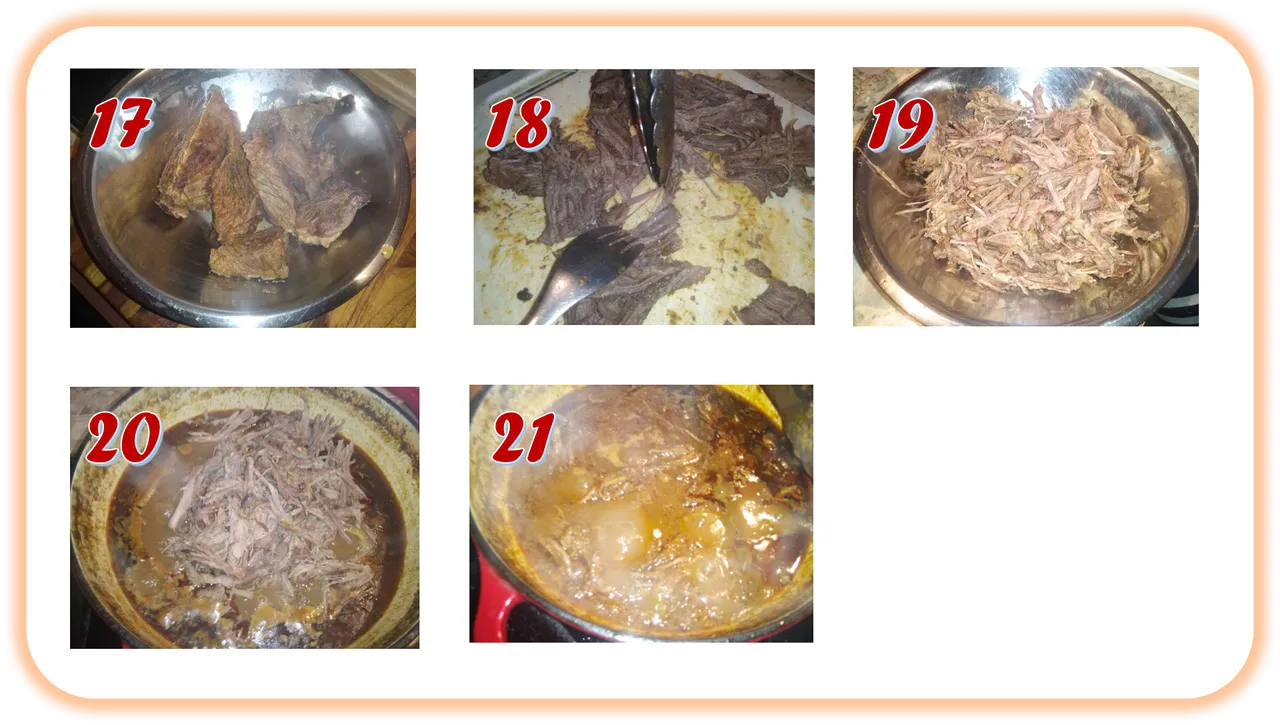

La birria suele servirse en un tazón, donde se coloca carne, cubierta con el consomé y se le añade un poco de cebolla picada en cubitos y cilantro, se le suele añadir un poco de jugo de limón y acompañarla con tortillas de maíz.
Otra forma de comerla es en tacos, en cuyo caso se humedecen las tortillas en le consomé y se colocan en una sartén a calentar, se les coloca queso, la carne deshebrada, cilantro y cebolla un poco de salsa o guacamole y se disfrutan mojándolos en un poco de consomé, antes de morderlos.
En nuestro caso preparamos unos tacos menos complicados, como nuestras tortillas estaban recién hechas y aun calientes, les colocamos la carne, un poco de queso y una guasacaca típica de mi país, y así los comimos, sólo yo los moje en un poco de consomé antes de comerlos, esto último les da un toque especial, aunque hay que comerlos con mucho cuidado para no mancharse la ropa. Espero que los puedan preparar y los disfruten.
The birria is usually served in a bowl, where meat is placed, covered with broth and a little diced onion and cilantro is added, a little lime juice is usually added and accompanied with corn tortillas.
Another way to eat it is in tacos, in which case the tortillas are moistened in the broth and placed in a pan to heat, put cheese, shredded meat, cilantro and onion, a little salsa or guacamole and enjoy dipping them in a little broth, before biting into them.
In our case we prepared some less complicated tacos, as our tortillas were freshly made and still warm, we put the meat, a little cheese and a typical guasacaca from my country, and that's how we ate them, only I dipped them in a little consommé before eating them, this last one gives them a special touch, although you have to eat them very carefully so as not to stain your clothes. I hope you can prepare them and enjoy them.

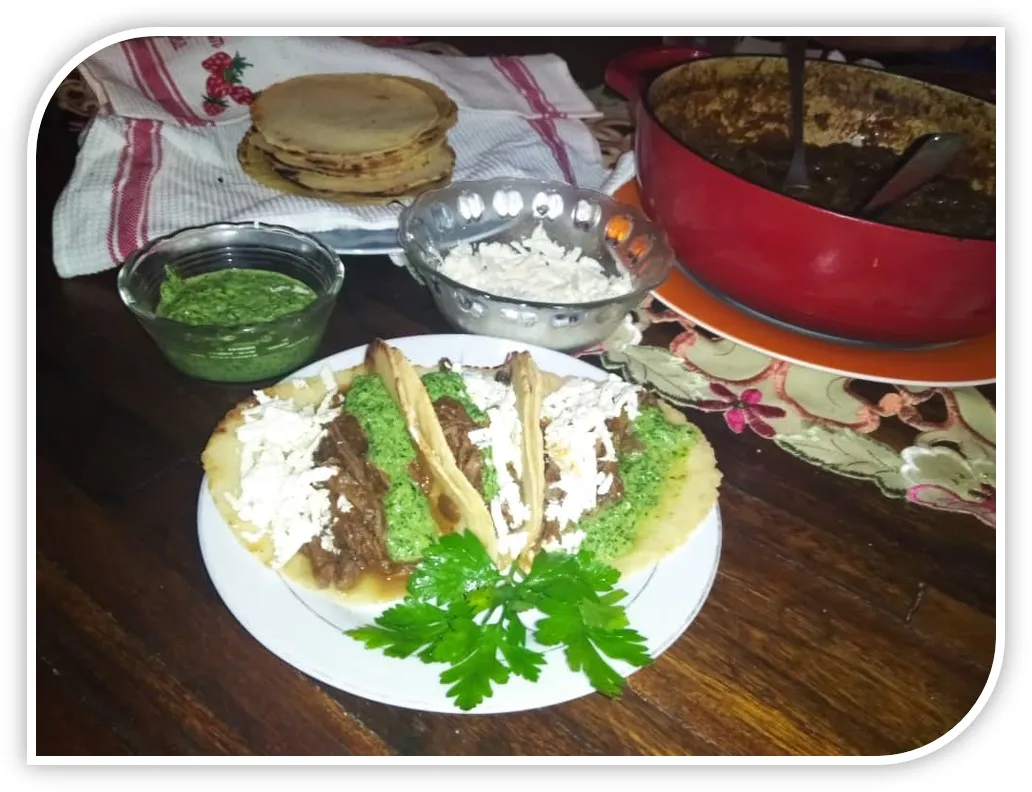
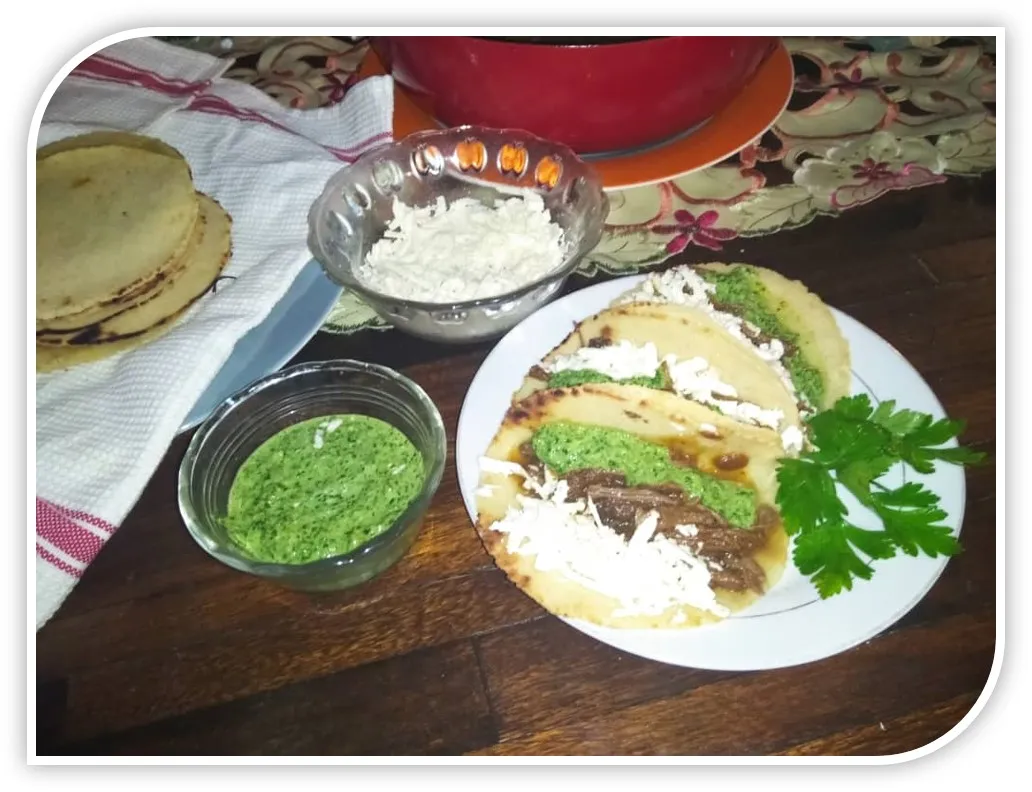

Todas las fotografías fueron tomadas con un movil Redmi 8A